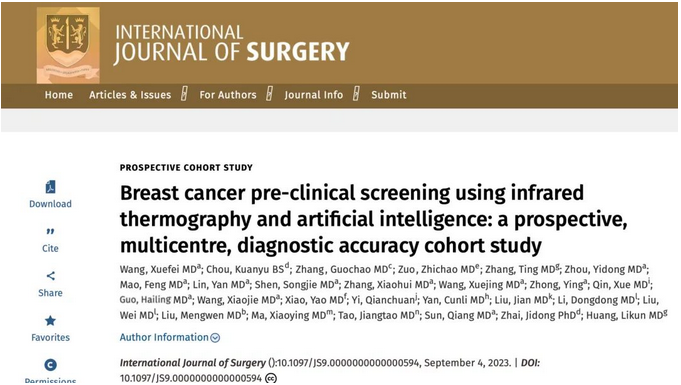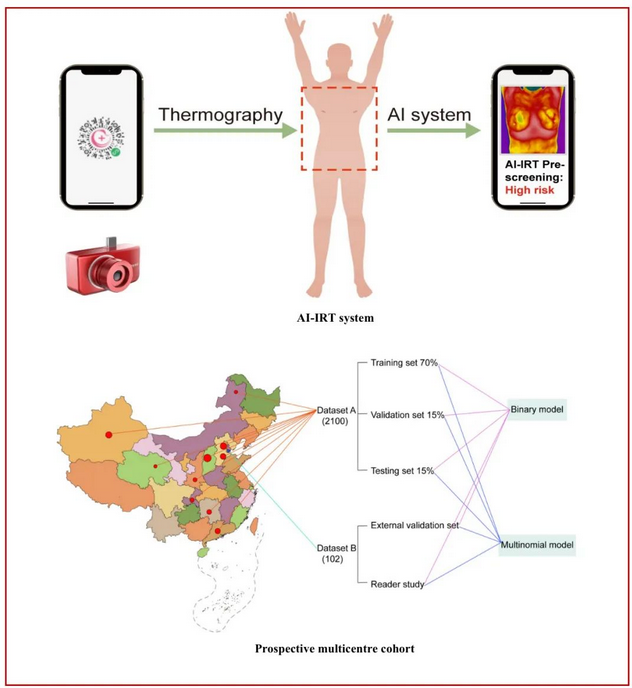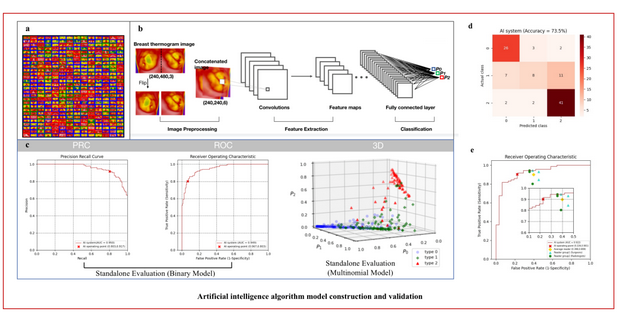On September 4, 2023, the team led by Prof. Sun Qiang and attending physician Wang Xuefei from the Department of Breast Surgery, PUMCH published their latest research findings on breast disease screening in the prestigious “International Journal of Surgery” (IF: 15.3, JCR Q1). The team applied mobile phone-artificial intelligence-based infrared thermography (AI-IRT), which they developed on their own, to pre-clinical screening for breast cancer. They conducted a prospective, multicentre, diagnostic accuracy cohort study and constructed IRT datasets and AI algorithm models to evaluate the effectiveness and safety of AI-IRT. This research fills a research gap in pre-clinical screening of breast cancer worldwide and holds the potential to change the traditional understanding and approach to breast cancer screening. It can help optimize breast cancer screening strategies and improve the patient overall survival.

As the malignant tumor with the highest incidence rate among Chinese women, breast cancer poses a significant threat to women’s health and lives. Large-scale breast cancer screening can reveal more early-stage cases. However, over 50% of the global population, for various reasons, have no access to clinical screening. Moreover, Asian women often have dense breast tissue, requiring screening strategies different from those used in the West. Therefore, we are in dire need of effective, convenient, and cost-efficient approaches to large-scale breast cancer screening in China.
For over a decade, the breast surgery team at PUMCH has been exploring practical and effective breast cancer screening models suited to different populations. The mobile AI-IRT developed by the team independently is applied to pre-clinical screening of breast diseases. The team constructed two prospective datasets and different algorithm models, performed internal and external validation. The research revealed that AI-IRT demonstrated a relatively high level of consistency across populations with different demographic characteristics. The research team also compared the diagnostic accuracy of the AI model with that of six physicians with expertise in analyzing IRT images. The findings indicated that the accuracy of the AI-IRT system surpassed the average image interpretation skills of the physicians, suggesting that the use of this system alone holds potentially high value for application.

▲The AI-IRT system and national prospective multi-center cohorts
The team developed a binary and a multinomial model and chose the former for breast cancer screening. The AUROC (area under the receiver operating characteristic curve) of the binary model for identifying low-risk and intermediate/high-risk patients was 0.9487 (95% CI: 0.9231–0.9744) in Dataset A and 0.9120 (95% CI: 0.8460–0.9790) in Dataset B. These results demonstrate that the system shows high diagnostic performance and good stability in breast disease screening.

▲The AI model
The AI-IRT system is non-invasive, radiation-free, and user-friendly, thus helping reduce unnecessary clinical examinations. The system consists of an infrared micro camera connected to a smartphone, AI-powered software, and an IRT database updated in real time. Users can send IRT images captured in real time to the AI software by following the instructions and then receive a risk assessment grade. For patients whose breast volume reaches a certain threshold, wearing a special-material bra can improve the screening accuracy. Family members can share the AI-IRT system for screening, and patients can also undergo AI-IRT screening at community health service centers. The potential value of the AI-IRT system in applications is huge.
This research was led by PUMCH in collaboration with Tsinghua University and 20 medical institutions from ten regions nationwide. The team has, in partnership with the Zhongguancun Medical Engineering Research Institute, completed the technological translation of the core hardware of this system.
Written by Chen Xiao and Wang Xuefei
Translated by Liu Haiyan
Reviewed by Wang Xuefei and Wang Yao
